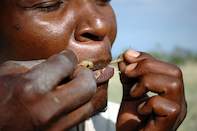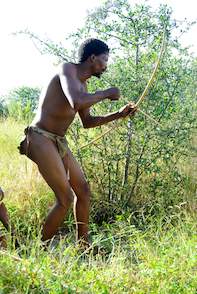Ever wondered what do Bushmen eat? While hunting is the most revered of skills to the Bushmen of Botswana, it is the women and children who gather most of the group's food.

The so-called "veldkos" will consist of berries and bulbs, eggs collected and any small animals they come across including tortoises and spring hares dug up from their burrow with long digging sticks, insects and their juicy larvae (except for the arrow-poison grubs). Favourites are the grewia or brandy-bush berries, which are tart and particularly juicy, and the bitter-tasting bulb (Raphionacme burked) which provides large quantities of liquid for several thirsty people.
The Bushmen of the Central Kalahari have become adapted to a place where resources are as critically limited as any place on earth can be. Conservation of these resources is central to their survival. Even the scrapings while preparing a skin will find their way into a meal. While there is an uncanny affinity between the Bushmen and nature, iclacks the sentimentality that modern-day life has imbued it with. A yellow-billed hornbill sealed up in its nest with mud, for example, will be dug out and the mother and chicks grabbed to be eaten.
The Bushman's Bow

In the dry seasons, the group of gatherers will move from melon patch to melon patch, consuming up to five kilograms a day for liquid and most of their requirements. They will also always watch for bees flying at dusk and heading for their hives. The wife of the great god #Goa!na (who branded the animals with their patterns and separated them from humans) is the mother of all hives. If a Bushman marks a hive and someone else takes the honey, it is considered a crime akin to stealing a person's water or cutting down a shade tree, an offence punishable by death.
The greater honeyguide (Indicator indicator) recognises the Bushmen as super predators and has developed a singular symbiotic skill. The weaver-size bird will come to a tree and issue its strident rattling call to attract a man's attention. The Bushman knows the honeyguide will show him a hive where the best treat of all awaits - honey. But in turn he must leave bits of honeycomb Mith honey and bee grubs for the bird or, next time, it will lead the man to a nest of a mamba or a cobra. (Everybody living close to nature in the Kalahari, whether Bushman Or other, will attest to this amazing béhaviour).
Specific larvae are left for the men to deal with. And then only to the most experienced hunters — the success of family and clan depends on the skill of its hunters. There is an aura of magic as the grubs of Diamphidia and Polyclada beetles are unearthed from between the roots of a commiphora or kanniedood (cannot die) bush, using fire-hardened digging sticks. The cocoon crust is broken open with great care and the body juices delicately squeezed out.
The potent neuro-toxin is used as arrow poison and any careless contact with an open cut or fingers to the mouth leads to certain death. The poison is mixed with plant juices for adhesion and is applied to the arrow shaft, never to the bone or metal tip, in case of injury.
The Bushman's bow is not a killing weapon and can deliver its dart to only about 50 metres with any accuracy. The hunter has to stalk his prey and shoot it with a poisoned arrow — the shaft separates and leaves only the tip in the animal. He then has to pursue it in the searing heat of the thornveld while the poison takes effect: it could take a few hours for a small antelope but it could take up to two days if it is an eland or giraffe.

